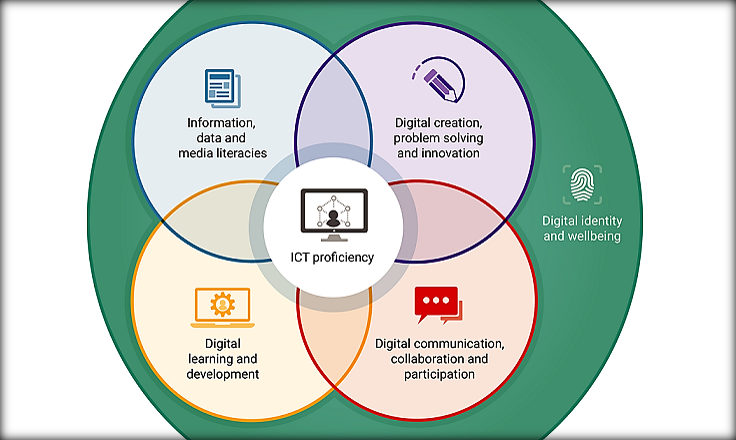
At a recent LTSEC meeting, the university agreed to adopt the Jisc Digital Capabilities Framework. But how much do you know about digital capabilities and how do digital capabilities differ from digital skills or digital literacy. What about digital fluency? All good questions and in this blog post I’ll try and help untangle some of those distinctions and explain how the Jisc Digital Capabilities Framework can help you as an individual, within your curriculum and help your students.
You say potato, I say potahto
Over the last decade there has been a range of terms used to describe those practices we engage with when we are using digital technologies, software and services. Jisc in its early explorations into this area used the term ‘digital literacy’, in part reflecting the work of SCONUL and it’s 7 pillars of information literacy which had a digital literacy lens on this work. There was also the significant piece of research undertaken by the LliDA project looking at Learning Literacies for the Digital Age.
Fast forward ten years and we now have Uk Government industrial and digital strategies both recognising the importance of digital skills not only in terms of economic growth but in terms of the general populace needing a level of digital capability to engage and work in today’s society and economy.
So what exactly are Digital Capabilities?
Jisc have defined digital capabilities as those skills, competencies and capabilities ‘which equip someone to live, learn and work in a digital society’. Perhaps the easiest way to distinguish between digital skills and digital capabilities is to consider writing a sophisticated report. I need the digital capability to determine the best way to write that report (considering the medium and audience) and then use that capability to critical evaluate the range of digital tools I could use to write it. I then need to apply my digital skills when actually using a specific tool (say MS Word, in this example) to actually undertake the activity. Both are important and we often develop our digital capabilities through increasing our confidence in developing and applying our digital skills. However, there’s a risk that we can get focused only on the digital skills and the understandable concern around the need to be continually learning how to use the new tools that our institutions are implementing. By taking a step back we can see how a focus on digital capabilities can actually better prepare us and our students for the inevitable change in digital tools and services that occurs either within our institutions or beyond.
Why adopt a Framework?
The Jisc definition of digital capabilities comes with a handy framework that articulates those skills and capabilities in a set of elements that makes sense in an educational context. Their framework has six elements that categorise those skills and capabilities
- ICT proficiency
- Information, data and media literacies
- Digital creation, problem solving and innovation
- Digital learning and development
- Digital communication, collaboration and participation
- Digital identity and wellbeing
Complimenting this framework are some profiles that articulate those capabilities in specific role contexts, for example in their Learner profile or their HE Teacher profile.
The framework and the profiles give you a common vocabulary from which to start discussions about digital capabilities, either within the curriculum or beyond it. It a foundational element of a whole range of discussions from capabilities within the curriculum to what are the right tools to support digital capabilities.
So how does that help me or my students?
The usefulness of the framework comes in the discussions that can be had about digital capabilities. For example, looking at the Learner Profile, what are the digital capabilities that the students on my course should be graduating with? How do I develop those within the curriculum? What digital skills and capabilities am I assuming students starting my course already have? Do I/the course team have the capabilities to help my students develop theirs? And if we don’t who can help?
The framework is never a means and an end in of itself but rather a way to better map out the space within the curriculum for those relevant capabilities. It can provide ways for students and ourselves to develop the tangible digital practices with various digital tools and services that are the practical application of those capabilities.
OK, so where should I start?
Firstly, have a look at the Framework and the groupings in general, a lot these will be things you are already doing. Are there any areas where maybe there are some gaps?
Do the capabilities outlined in the Learner Profile support your course or module learning outcomes in anyway?
Alternatively, in the HE Teacher Profile are there any areas that you would personally like to develop more expertise in? Sometimes, it’s the conversations and ideas that get sparked off reviewing a framework that are the most valuable part of having the Framework.
The Jisc Digital Capabilities Framework helps underpin a range of activity and development as we move forward with digital learning and teaching. It helps us have more in-depth discussions about digital capabilities and provides a way to understand more explicitly where we are developing them with and beyond the curriculum.
Want to keep up to date with all the latest developments in Digital Learning and Teaching or more broadly as part of our approach to realising teaching excellence? Then subscribe to our updates or follow us on twitter @l_t_worc.
Image – Jisc Building digital capabilities: the six elements defined (this work is licensed under CC BY-NC-SA)
